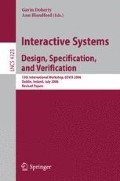Abstract
Visual technologies have directly influenced the specification and implementation of virtual environments and the user interactions that can be supported. However, recent advances in haptic devices have facilitated new levels of virtual environment interaction by the development of environments where it is possible to touch and feel virtual objects. Such environments support a richer set of possible user interactions.
This paper explores haptic specification for virtual environment interaction. The aim is to provide a sketch of interaction to enable analysis of usability requirements in an example haptic technology.
Access this chapter
Tax calculation will be finalised at checkout
Purchases are for personal use only
Preview
Unable to display preview. Download preview PDF.
References
Biggs, S.J., Srinivasan, M.A.: Haptic interfaces. In: Stanney, K.M. (ed.) Handbook of Virtual Environments, pp. 93–115. Lawrence Erlbaum Associates, New Jersey (2002)
Bordegoni, M., et al.: The role of continuity in haptic interaction systems. In: CHI 2000 Workshop: Continuity in Human Computer Interaction, L’Aia, Netherlands, April (2000)
Bowman, D.A., et al.: 3D User interfaces: Theory and Practise. Addison-Wesley, Reading (2005)
Degani, A., Shafto, M., Kirlik, A.: Modes in automated cockpits: Problems, data analysis and a modelling framework. In: 36th Israel Annual Conference on Aerospace Sciences Conference, Haifa (1996)
Dix, A., et al.: Human-Computer Interaction, 3rd edn. Pearson/Prentice Hall, Harlow (2004)
Dubois, E., et al.: Beyond user experimentation: notational-based systematic evaluation of interaction techniques in virtual reality environments. Virtual Reality 8, 118–128 (2005)
Hansen, K.V., et al.: Modelling of interaction between a spatula and a human brain. Medical Image Analysis 8, 23–33 (2004)
Jacob, R.J.K., Deligiannidis, L., Morrison, S.: A software model and specification language for non-WIMP user interfaces. ACM Transactions on Computer-Human Interaction 6(1), 1–46 (1999)
Kalawsky, R.S.: The Science of Virtual Reality and Virtual Environments. Addison-Wesley, Reading (1993)
Massink, M., Duke, D., Smith, S.: Towards hybrid interface specification for virtual environments. In: Duke, D.J., Puerta, A. (eds.) Design, Specification and Verification of Interactive System ’99. Springer Computer Science, pp. 30–51. Springer, Wien (1999)
Mine, M.R., Brooks Jr., F.P., Sequin, C.H.: Moving objects in space: Exploiting proprioception in virtual-environment interaction. In: Whitted, T. (ed.) SIGGRAPH 97, ACM SIGGRAPH, pp. 19–26. ACM Press, New York (1997)
Navarre, D., et al.: A formal description of multimodal interaction techniques for immersive virtual reality applications. In: Costabile, M.F., Paternó, F. (eds.) INTERACT 2005. LNCS, vol. 3585, pp. 170–183. Springer, Heidelberg (2005)
Newman, W.M., Lamming, M.G.: Interactive System Design. Addison-Wesley, Harlow (1995)
Nielsen, J.: Usability Engineering. AP Professional, Boston (1993)
Poppen, J.L.: An Atlas of Neurosurgical Techniques. W.B. Saunders Company, Philadelphia (1960)
Scaife, M., Rogers, Y.: Informing the design of a virtual environment to support learning in children. International Journal of Human-Computer Studies 55(2), 115–143 (2001)
Shaer, O., Jacob, R.J.K.: Toward a software model and a specification language for next-generation user interfaces. In: ACM CHI 2005 Workshop: The Future of User Interface Design Tools, April 2005, ACM Press, New York (2005)
Shneiderman, B.: Designing the User Interface: Strategies for Effective Human-Computer Interaction, 3rd edn. Addison-Wesley, Reading (1998)
Smith, S., Duke, D., Massink, M.: The hybrid world of virtual environments. Computer Graphics Forum 18(3), C297–C307 (1999)
Smith, S.P., Duke, D.J.: Binding virtual environments to toolkit capabilities. Computer Graphics Forum 19(3), C-81–C-89 (2000)
Smith, S.P., Harrison, M.D.: Editorial: User centred design and implementation of virtual environments. International Journal of Human-Computer Studies 55(2), 109–114 (2001)
Stanney, K.M., Mourant, R.R., Kennedy, R.S.: Human factors issues in virtual environments: A review of the literature. Presence 7(4), 327–352 (1998)
Wall, S., Brewster, S.: Editorial: design of haptic user-interfaces and applications. Virtual Reality 9(2-3), 95–96 (2006)
Wieting, R.: Hybrid high-level nets. In: Charnes, J.M., et al. (eds.) 1996 Winter Simulation Conference, Coronado, California, USA, pp. 848–855 (1996)
Willans, J.S.: Integrating behavioural design into the virtual environment development process. PhD thesis, University of York. Technical Report YCST 2002/02 (2001)
Willans, J.S., Harrison, M.D.: A toolset supported approach for designing and testing virtual environment interaction techniques. International Journal of Human-Computer Studies 55(2), 145–165 (2001)
Wüthrich, C.A.: An analysis and a model of 3d interaction methods and devices for virtual reality. In: Duke, D.J., Puerta, A. (eds.) Design, Specification and Verification of Interactive System ’99. Springer Computer Science, pp. 18–29. Springer, Wien (1999)
Author information
Authors and Affiliations
Editor information
Rights and permissions
Copyright information
© 2007 Springer Berlin Heidelberg
About this paper
Cite this paper
Smith, S.P. (2007). Exploring the Specification of Haptic Interaction. In: Doherty, G., Blandford, A. (eds) Interactive Systems. Design, Specification, and Verification. DSV-IS 2006. Lecture Notes in Computer Science, vol 4323. Springer, Berlin, Heidelberg. https://doi.org/10.1007/978-3-540-69554-7_14
Download citation
DOI: https://doi.org/10.1007/978-3-540-69554-7_14
Publisher Name: Springer, Berlin, Heidelberg
Print ISBN: 978-3-540-69553-0
Online ISBN: 978-3-540-69554-7
eBook Packages: Computer ScienceComputer Science (R0)

